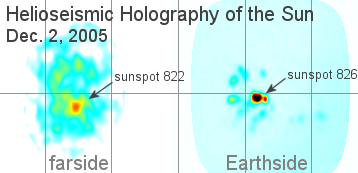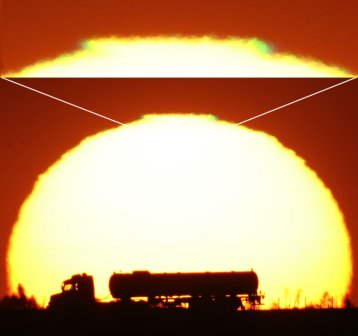 Auroras for Christmas? It could happen... Sign up for SpaceWeather PHONE.
Auroras for Christmas? It could happen... Sign up for SpaceWeather PHONE.
VENUS & THE MOON: Venus and the crescent moon are side-by-side today--a beautiful pair. Look for them in the southern sky at sunset. They're so bright, you can see them even before the sky fades completely black: sky map.
BIG SUNSPOTS: There are two big spots on the sun today, but we can see only one of them. Sunspot 826 is plainly visible on the Earth-facing side of the sun. It has been growing madly in recent days and poses a threat for Earth-directed solar flares.
The other big sunspot is on the farside of the sun, almost precisely opposite sunspot 826. It appears in this helioseismic image of the whole sun:

The farside spot is almost certainly old sunspot 822, which crossed the Earth-facing side of the sun two weeks ago. That photogenic sunspot will reappear on Dec. 9th or 10th when the sun's rotation turns it toward Earth again. Stay tuned.
GREEN PATCHES: The Sun is a G-type star, which means its surface temperature is about 6000°C and its color is yellow. So where does the green come from? On Nov. 26th, when "Mendonça Jr." of São Luis do Purunã, Brazil, photographed the sunset, he noticed some green patches around the edge of our star: (continued below)

Atmospheric optics expert Les Cowley has the answer:
"Low cost binoculars and telescopes put colored fringes around stars or tree branches silhouetted against the sky. Their imperfect lenses focus blue and red light differently. Earth's atmosphere is also an imperfect lens and it rims the top of the setting sun with green."
"Why green?" he asks. "It would be blue but the air and dust have scattered that color away. The green rim is too narrow to see by eye. People can, however, see a green flash, which needs needs a mirage to magnify the color separation."

